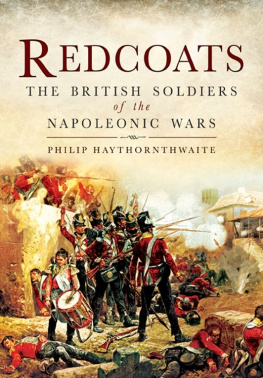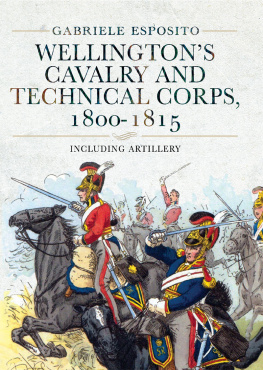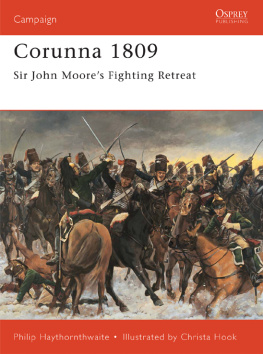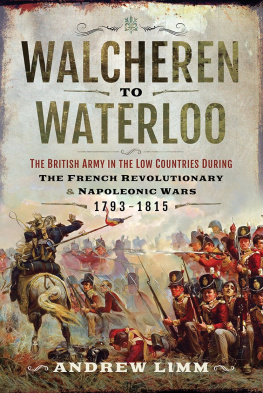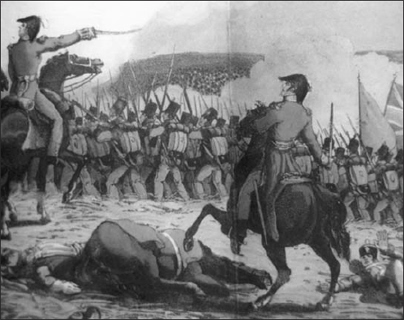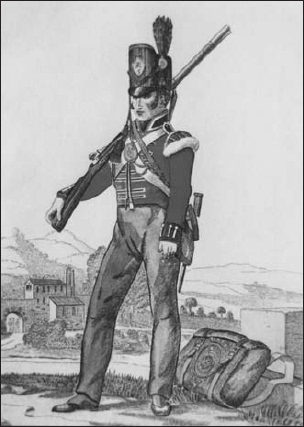Elite 164
British Napoleonic Infantry Tactics 17921815
Philip Haythornthwaite Illustrated by Steve Noon
Consultant editor Martin Windrow
CONTENTS
BRITISH NAPOLEONIC INFANTRY TACTICS 17921815
INTRODUCTION: THAT ARTICLE
T he Duke of Wellingtons comment upon the British infantry, made just before the opening of the Waterloo campaign, is well known: asked about the outcome of the approaching hostilities, he pointed to an off-duty infantryman and said, There it all depends upon that article whether we do the business or not. Give me enough the infantry had formed the backbone of his victorious army in the Peninsular War, that was high praise indeed.
The reasons given at the time and later for the excellence of the infantry included such factors as the obduracy and determination of the individual soldier, discipline, leadership, and the regimental system. A commentator who interviewed officers from almost every regiment present
That article: the foundation of infantry tactics was the ordinary infantryman here a private of the light company of the 5th (Northumberland) Regiment of Foot, 1815. (Print by Genty)
This last qualification acknowledged that the infantry did indeed falter at times though Wellington remarked that he was never overly concerned about troops running away, provided that they came back; but the attribution of steadfastness entirely to regimental spirit leaves out of the equation another and most important contributory factor in producing this efficiency the system of tactics.
THE MANUALS
In the period preceding the commencement of the French Revolutionary Wars the British infantry had no unified system of drill, so that every commanding officer manoeuvred his regiment after his own fashion; and if a brigade of troops were brought together, it was very doubtful whether they could execute any one combined movement, and almost certain that they could not execute the One commentator remarked that no matter how talented a general, without a common system it was impossible to attempt the most simple manoeuvres before an enemy, much less such complicated ones as the circumstances of the situation may point out and require. This author was the individual who did most to remedy the problem: David Dundas.
Dundas Principles of Military Movement
The son of a prosperous Edinburgh merchant, Dundas was born in 1735 and entered the military academy at Woolwich in 1750; he trained and worked as a surveyor, was commissioned in the Royal Artillery in 1754, then served in the Royal Engineers, infantry and cavalry, and in staff positions during the Seven Years War. Subsequently he attended Prussian, Austrian and French military exercises, and became an expert in drill and manoeuvre. In 1788 he published Principles of Military Movements, a manual intended to produce a practical system; and in June 1792 the Adjutant General, William Fawcett, on behalf of the king, ordered that an amended version should be issued officially, Rules and Regulations for the Movements of His Majestys Infantry. This stated that it was highly expedient and necessary, for the benefit of the service at large, that one uniform system of Field-Exercise and Movement, founded on just and true principles, should be established, and invariably practised, throughout His [Majestys] whole Army [and] strictly adhered to, without any deviation whatsoever therefrom.
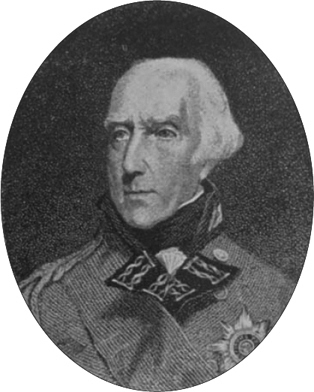
The architect of infantry tactics: Gen Sir David Dundas Bt (17351820), known as Old Pivot from his system of manoeuvre. He held various commands, including the post of commander-in-chief (180911), but it was his tactical system that was his great contribution to the British military establishment. (Print after R.Owen)
The adoption of Dundas system must have been patchy, however, for when)
The Eighteen Manoeuvres
The Eighteen Manoeuvres in Dundas manual formed a sequence to be performed during a review, involving the drills described in detail elsewhere in the manual. They were intended to encompass much of what would be required on the battlefield, and though often mentioned in later works they are rarely described. They were:
1 From line, form close column of companies upon the grenadiers; form close column by grand divisions (i.e. with two-company frontage); deploy again into line upon the light company.
2 Form close column of companies in front of light infantry; form close column with two-company frontage; deploy into line.
3 Form close column of companies upon one of the centre companies, facing to rear; countermarch, and deploy into line upon a centre company.
4 Change of position in open column: line wheels to take up oblique position.
5 Wing thrown back: line wheels to take up a position parallel to its original position.
6 Line wheels into open column; forms close column; opens; forms solid square; takes on position of Prepare to receive cavalry, two front ranks kneeling; rear ranks commence file-firing; cease; kneeling ranks fire volley.
7 Countermarch by files: right-wing company becomes left and vice-versa, and so along the line.
8 March in open column: battalion wheels into line.
9 Echellon [sic] change of position: open column wheels to take up a position at an oblique angle to the original.
10 Change of position: line wheels using light company as a pivot.
11 Change of position: line forms open column, advances, re-forms line.
12 Retreat in line: battalion retires 50 paces covered by light company in skirmish order; halts, fires twice by companies from centre to flanks; retires 250 paces by alternate companies in stages of 50 paces; forms line, retires 50 paces, halts, fronts. Light company divides into two wings during this process, assembles at rear and then resumes its place on left wing.
13 March to a flank in Echellon: companies wheel to right, advance in echelon, re-form line, fire three times by companies, from flanks to centre.
14 Form hollow square; square advances with one corner leading, then with one face leading; fire by companies; re-form line from square.
15 Line retires 100 paces, covered by light company; then retires by files, halts in open column, wheels back into line; light company retires through it and re-assembles 30 paces to the rear.
16 Firing, advancing, and charging to the front: battalion advances 50 paces in line; files to the front, covered by light company, 50 paces, halts in open column, wheels into line; advances in line 50 paces, then fires four times by alternate half-battalions; light company retires and re-forms in rear, half on each wing; advance in line 50 paces, fire volley, advance 20 paces and fire volley, then charge 50 paces; halt and load while light company moves forward to cover the battalion, pursues enemy and then returns to assemble on left flank.
17 Retire in line 100 paces; retire by alternate half-battalions, firing four times; retire 100 paces and halt. [Note: Dickinsons guide states that the light company should cover the retreat.]
18 Line advances 100 paces; fires twice; advances obliquely to right and left; advances 100 paces, fires twice.


